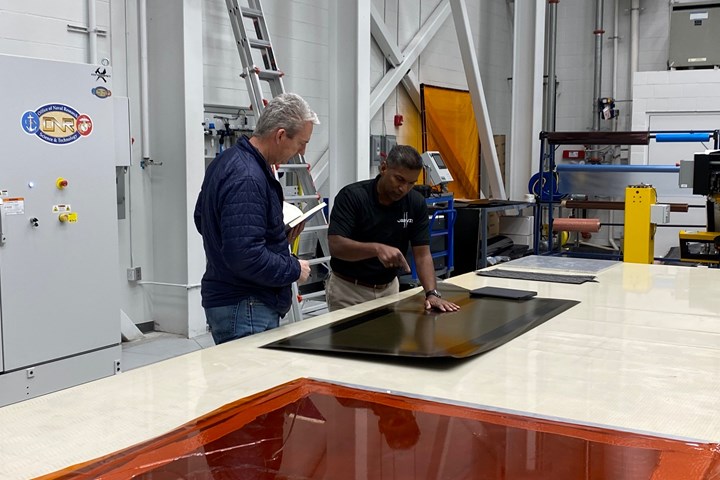CompositesWorld is on the road again
Since CW’s infancy, its editors have strived to imbue its coverage with a sense of place, whether that’s through plant tours, facility visits or trade shows. After a pandemic, this has never seemed more important.
Dr. Waruna Seneviratne, director – ATLAS at NIAR, offers CW editor-in-chief Jeff Sloan some pointers on composites manufacturing. Photo Credit: NIAR
A few weeks ago I was asked by someone I’d just met what I do for a living. I gave my standard answer and expected the standard reply — “Huh...” or “Oh...” — which I take to mean, “I’m not sure I understand what you just said.” But this time, I was surprised. The person I’d just met asked, “What is the one thing you’ve done as an editor of CompositesWorld that has been most impactful?”
No one has ever asked me this question, and for a moment I was struck with the type of anxiety that comes with a tough job interview (I challenge you to ask yourself the same question about your professional impact). So, I had to take a few seconds to think it over. My answer? “We go places,” I said, explaining that prior to my being hired in 2006, CW editors attended trade shows and conferences, but had no history of visiting the people (you) for whom we write. Once I joined, I wanted to imbue our coverage of the industry with a sense of place, and to use plant visits and tours as a way to help our audience understand how composite parts and structures are being designed, tooled, fabricated and finished.
Of course, during the pandemic we, like many of you, did not go many places. As COVID-19 vaccines rolled out in 2021 and a sort of normalishness returned, we were able, once again, to think about getting back out into the world. Other than trade shows and conferences, I have recently visited ATC Manufacturing (Idaho, U.S.), Bucci Composites (Italy), the National Institute for Aviation Research (NIAR, Wichita State University, Kansas, U.S.), Oribi Composites (Colorado, U.S.), AvCarb Material Solutions and Boston Materials (Massachusetts), and the Advanced Structures and Composites Center (ASCC, University of Maine, U.S.).
We are always on the lookout for people and places to visit.
Senior editor Ginger Gardiner has visited Victrex Composites Solutions (Rhode Island, U.S.), and Qarbon Aerospace (Georgia and Texas, U.S.). Associate editor Hannah Mason has visited Oak Ridge National Laboratories
and Magnum Venus Products (ORNL and MVP, Tennessee., U.S.), and Purdue University (Indiana, U.S.). We have published stories about many of these visits, and those we haven’t published yet are in the process of being written.
It was hard to know, before we started reconnecting with the industry in person, how the pandemic might have affected composites manufacturing in general. Although the sudden and dramatic reduction in commercial aerospace manufacturing had obvious negative impacts, we weren’t sure if or how the lockdown might affect innovation and creativity among material suppliers and fabricators. How could there not be a setback?
So, what have we found as we started visiting composites manufacturers again? My observation is that the pandemic not only failed to stifle innovation, but apparently created an environment in which it could flourish. That is, being confined to quarters allowed many fabricators to intensely focus on materials, technologies, projects and applications in a way that might have been challenging otherwise. I found that ATC, Bucci, Oribi, NIAR, AvCarb and Boston Materials were allowed to concentrate on technology developments that are already bearing fruit.
Ginger, for her part, says Victrex used the pandemic to prototype production runs of thermoplastic parts for advanced air mobility (AAM). The company also updated its materials and process simulations with tests after each project to increase accuracy and help speed future developments. Qarbon Aerospace maintained its aerostructures production while updating its production systems and infrastructure, preparing for the future growth it sees coming quickly in multiple markets. Both see thermoplastic composites as reaching a tipping point, and are maturing the technologies needed to achieve high-rate production.
Hannah notes that there’s been much opportunity for new R&D and creativity the last few years, including new consortia projects, startup companies and emerging technologies in composites recycling and other sustainability initiatives. And in automotive, creative solutions are hitting the market for composites in electric vehicles, especially in battery enclosures.
We are always on the lookout for people and places to visit. Let us know if your door is open.
Related Content
A return to the Space Symposium: Charting the next frontier
Since 2019 the space sector has been on a rapid upward trajectory. This year’s Space Symposium delivered that same optimism, celebrating the community’s continued proliferation, even as political and financial uncertainty raise new questions.
Read MoreRevisiting the OceanGate Titan disaster
A year has passed since the tragic loss of the Titan submersible that claimed the lives of five people. What lessons have been learned from the disaster?
Read MoreFall events chart the course for composites
A busy fall brings industry-leading events and recognition for operations setting new benchmarks for excellence.
Read MoreParis Air Show highlights advanced materials, industry momentum
This year’s international air show offered a glimpse of the rapidly expanding future for composites in aerospace.
Read MoreRead Next
Next-gen fan blades: Hybrid twin RTM, printed sensors, laser shock disassembly
MORPHO project demonstrates blade with 20% faster RTM cure cycle, uses AI-based monitoring for improved maintenance/life cycle management and proves laser shock disassembly for recycling.
Read MoreScaling up, optimizing the flax fiber composite camper
Greenlander’s Sherpa RV cab, which is largely constructed from flax fiber/bio-epoxy sandwich panels, nears commercial production readiness and next-generation scale-up.
Read MoreCutting 100 pounds, certification time for the X-59 nose cone
Swift Engineering used HyperX software to remove 100 pounds from 38-foot graphite/epoxy cored nose cone for X-59 supersonic aircraft.
Read More























